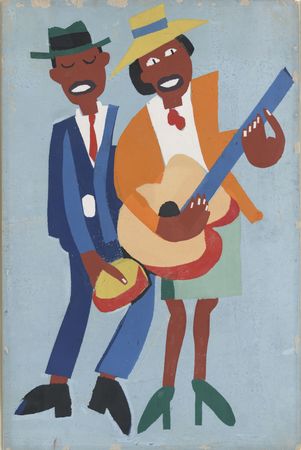
Home | Gallery
Guide | The Provincetown AIDS Art Archives Contact Us | How You Can Help
Contact Us | How You Can Help
A | B | C | D | E | F | G | H | I | J | K | L | M | N | O | P | Q | R | S | T | U | V | W | Y | Z
William H. Johnson
(1901-1970)

Museum of Modern Art: William H. Johnson. (American, 1901-1970). Blind Singer. c. 1940. Screenprint with tempera additions, composition and sheet: 17 1/2 x 11 1/2" (44.5 x 29.2 cm). Publisher: unpublished. Printer: the artist. Edition: unknown.
Publication excerpt
Deborah Wye, Artists and Prints: Masterworks from The Museum of Modern Art, New York: The Museum of Modern Art, 2004, p. 220
William H. Johnson was among the foremost painters of African-American life during the Harlem Renaissance. Born in South Carolina and educated in fine arts in New York and Provincetown, Johnson spent most of his time from the mid-1920s to the late 1930s in Europe, where he was influenced by Post-Impressionism and Expressionism. After achieving critical acclaim abroad, he returned to New York permanently in 1938 under the threat of war and with a desire to reconnect to his roots. The move produced a dramatic change in his work. Assigned by the government's Works Progress Administration to teach at the Harlem Community Art Center, Johnson became immersed in the sights, sounds, and people of New York's African-American community, which he captured in compositions of flat shapes, patterned designs, and brilliant colors that were distinctly modernist in their simplicity and directness.
During his lifetime, Johnson created more than seventy-five prints. While in Europe he produced woodcuts and linoleum cuts, usually with hand coloring, inspired by the raw power of German Expressionism. After returning to New York, he took up screenprint and pochoir, techniques that suited his new embrace of simplified forms and bold colors. He printed these works on assorted found papers and often completed his images by hand with tempera, making each print slightly different from the next. He frequently experimented with subjects by printing compositional variants and also rendering them in drawing and painting, each format enriching the other, but with the printed versions the most simplified of all.
Notable among Johnson's New York prints are those that capture the essence of Harlem's fashion, music, and dance. This print, entitled Blind Singer, shows a pair of musicians in an open-air performance that was common on the city's bustling streets. The composition's flatness, pure color, and orchestrated angularity endow this still image with a sense of rhythmic motion and dynamic energy.
Judy Hecker [http://www.moma.org/collection/]
Johnson left his native South Carolina in 1918 to study at the National Academy of Design
in New York. Although he was acknowledged as the most talented artist in his class of 1926,
he was passed over for a traveling scholarship, most likely because of his race. Rather than
see Johnson flounder in the United States, his teacher, Charles Hawthorne, gave Johnson
$1000 so that Johnson could travel to Europe. This act of faith and generosity was pivotal in
Johnson's life, for it provided the seed from which his career flourished.
..................................................
Established in 2001 © Provincetown Artist Registry | P.O. Box 675, North Truro, MA 02652 | 508 487-0011